America’s inland waterways system is vital to our nation’s competitiveness and economic growth. The inland waterways efficiently, sustainably, cost-effectively, and safely transport critical commodities like agricultural goods, energy products, building materials and industrial chemicals to destinations within the U.S. and to deep water ports for export.
The system includes a vast network of 12,000 miles of connecting waterways and 219 locks. However, the majority of locks and dams on the Mississippi River system were constructed during the 1930s and are operating well beyond their 50-year design life. Modernizing the nation’s inland waterways system will support and create American jobs, increase U.S. exports, and inject billions of dollars into the U.S. economy to power our growth for the next 50 years.
CLICK YOUR STATE TO LEARN MORE
AN INLAND MARINE HIGHWAY FOR FREIGHT

In 2021, about 500 million tons of waterborne cargo transited America's inland waterways, a volume equal to roughly 14% of all intercity freight.
These products, valued at over $158 billion, were shipped on the portions of our 12,000 miles of inland waterways system that generate revenue for capital improvements by a fuel user fee on commercial vessels. Those funds, comprising the Inland Waterways Trust Fund, provide a cost-share for construction and rehabiltation of some 240 lock sites.
All that, and the least expensive, safest, most energy-efficient, and lowest carbon footprint.
America's “inland marine highways” move commerce to and from 28 states, serve industrial and agricultural centers, and facilitate imports and exports at gateway ports.
MOVING THE NATION’S COMMODITIES
By safely moving America’s cargo at the lowest cost, barge transportation plays a vital role not just to our nation’s economy, but in preserving our environment and limiting traffic congestion through our neighborhoods.
Our lock and dam infrastructure helps barges move the products we use every day - the underpinnings of our economy.
|
Barges are ideal for hauling bulk commodities and oversized or overweight equipment, including:
|
Which States Move the Most? (2016 data, U.S. Waterborne Commerce statistics)
Navigation Lock and Dam/Project Profiles (2016 data, U.S. Army Corps of Engineers)
Economic Impact of Inland Waterways - by state: Methodology
America’s economy benefits from the cost efficiencies barge transport provides over transport by truck or rail. More than 60% of the nation’s grain exports move by barge, helping our agricultural exports stay competitive in global markets.
Barge transport also keeps our nation’s vital energy sources flowing, fueling our industrial base and keeping our high-tech economy running. In fact, more than 22% of domestic petroleum and petroleum products and 20% of the coal used in electricity generation transit our inland waterways.
America’s safe, reliable and efficient inland river transportation system has been the envy of the world for more than a century.
Download Intermodal Comparison
Our inland waterways will need infrastructure reinvestment to ensure it can meet the demands of the 21st century to keep America competitive.
Barge transportation also contributes more than half a million jobs to the U.S. economy, according to a study, “Inland Navigation in the United States: An Evaluation of Economic Impacts and the Potential Effects of Infrastructure Investment”, commissioned by the National Waterways Foundation and executed by the University of Tennessee and the University of Kentucky. The study determined:
• If we invest in our inland waterways, we can sustain 541,000 jobs and more than $1 billion in new job income annually;
• Investment in badly needed modernization improvements to our inland waterways’ aging lock and dam infrastructure could lead to 350,000 job-years of new, full-time employment with a present value of more than $14 billion over the 10-year period examined in the study;
• If 21 priority navigation projects could be completed at an estimated cost of $5.8 billion total, the 20-year sum of related economic output activity would exceed $82 billion;
• If the completion of those projects were accelerated to 10 years, between 10,000 and 15,000 new jobs with an annual economic value of $800 million could become available. In the second decade, the completed navigation improvements could result in 10,000 new jobs throughout the economy each year with a total income of $740 million in the first year to more than $1 billion by year-20;

Download Liquid Cargo Comparison
• If commercial shipping on our waterways ceased entirely, there would be immediate, devastating economic consequences with a total 10-year loss of $1.063 trillion, when discounted to reflect that some of the loss is still several years away.
Shipping costs would increase by $12.5 billion, which would ultimately be passed onto American consumers in the form of higher costs for goods. The Gulf Coast and Lower Mississippi River regions would be hardest hit by a potential complete waterways system closure. High-value petrochemical products dominate industrial production in that region and alternative transportation in the region is limited;
• With the loss of waterways shipping, an estimated 75% of freight would be diverted to truck and/or rail, and there would be a 25% loss due to decreased production. Given that the capacity of just one standard river tow (15 barges) equals 1,050 trucks or 216 rail cars and six locomotives, the nation would face certain traffic gridlock;

The lock and dam infrastructure is in need of recapitalization, if waterways transportaion is to continue to be the safest, lowest-cost, lowest-carbon-footprint, most energy-efficient mode of surface transportation into the future.





